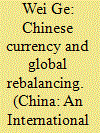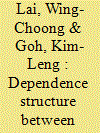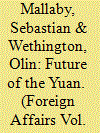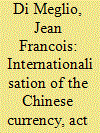|
|
|
Sort Order |
|
|
|
Items / Page
|
|
|
|
|
|
|
| Srl | Item |
| 1 |
ID:
122989


|
|
|
|
|
| Publication |
2013.
|
| Summary/Abstract |
Perceived to be substantially undervalued, the Chinese currency, the yuan, has attracted much attention in recent years, especially since the recession of 2008-2009. To remedy the situation, a proposal put forward recently by C. Fred Bergsten is noteworthy, for its impressive boldness in calling for drastic US policy actions, and for the potentially far-reaching impacts on the global rebalancing and recovery it may bring about. The purpose of this article is twofold: to assess the underlying analytical validity of this proposal and to explore its implications for the US, China and the rebalancing and recovery of the world economy.
|
|
|
|
|
|
|
|
|
|
|
|
|
|
|
|
| 2 |
ID:
176998


|
|
|
|
|
| Summary/Abstract |
This article investigates the linkages of the movements in Renminbi (RMB) to volatility of exchange rate returns of other currencies before and after the yuan devaluation on 11 August 2015. A comparison between the onshore Chinese yuan (CNY) and the offshore Chinese yuan (CNH) is made. Standard regression methods underestimate the tail dependence between yuan and other exchange rate volatility, as financial data are non-normally distributed, especially when extreme event occurs. We apply Gumbel copulas to capture the presence of tail dependence between RMB returns and the volatility of exchange rate returns for 13 selected currencies, and found dependencies not revealed by the standard ARCH models. The tail dependence has increased after the RMB devaluation, suggesting that RMB depreciation is associated with higher downside risks in these currencies. This is most obvious in the currencies of Asian and ASEAN-5 countries that have strong trade and financial linkages with China. The dependence structure has shifted away from the dominance of onshore CNY rates before the devaluation to the growing importance of more volatile offshore CNH rates after the devaluation. Hence, any large depreciation in CNH will lead to a higher volatility in the other exchange rate returns, and the corresponding downside currency risks are higher than those of the CNY.
|
|
|
|
|
|
|
|
|
|
|
|
|
|
|
|
| 3 |
ID:
108957


|
|
|
| 4 |
ID:
117921


|
|
|
|
|
| Publication |
2013.
|
| Summary/Abstract |
International commentators seem to have a consensus view that the Chinese yuan is substantially undervalued and the Chinese monetary authority must take speedy actions to redress the currency misalignment by rapid nominal revaluation. This paper argues for a gradualist but comprehensive strategy for adjusting the renminbi's exchange rate. Taking into consideration the facts that the yuan's undervaluation is caused by an array of domestic and international factors and that the Chinese central bank cannot effectively invest its growing holdings of foreign reserves, we develop a framework to provide a theoretical underpinning for the optimal strategy for the renminbi's gradual revaluation. With this strategy, the renminbi undervaluation problem is gradually redressed through a combination of nominal appreciation and higher inflation plus some other structural and macroeconomic policies. This strategy can also allow absorption of external imbalances, hence strengthening the foundation of China's long-term growth.
|
|
|
|
|
|
|
|
|
|
|
|
|
|
|
|
| 5 |
ID:
113975


|
|
|
|
|
| Publication |
2012.
|
| Summary/Abstract |
After two waves of important changes in the Chinese system of foreign exchange, one in July 2005, when the Chinese currency was allowed to fluctuate more widely against the US dollar, the other in June 2010, when it was then quoted against an undisclosed basket of currencies, but moreover, was allowed to be partially traded in Hong Kong with the invention of a 'twin', the 'offshore yuan' (CNH), a deep reform could have taken place. The creation of the CNH, allowing debt to be issued internationally in yuan, initially led to the belief that a real set of deep reforms was under way. Yet, like some reforms of the past, which were hesitant or even annulled, the path towards monetary and financial reform is encountering difficulty. The steps taken towards the 'regionalisation' or possibly the 'internationalisation' of the Chinese currency may well be taking the same route. Before the reforms have had time to come to fruition and deliver deep changes, there seems to be some indecisiveness, a sense of relative failure, or at least discovery of the limitations in a process which many, at least at the beginning, believed would be quick and decisive. This article attempts to demonstrate that, like some other Chinese reform processes of the past, the path is not yet very clear and claims of deep changes and unwavering success would be largely premature.
|
|
|
|
|
|
|
|
|
|
|
|
|
|
|
|
|
|
|
|
|